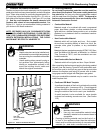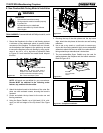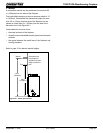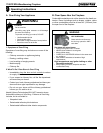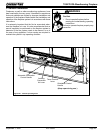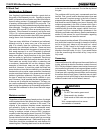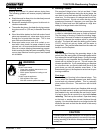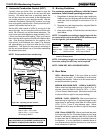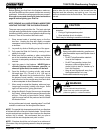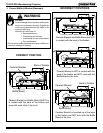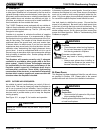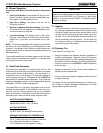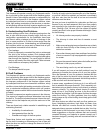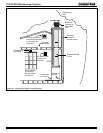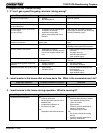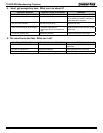
September 1, 2008
433-1390G
Page 49
7100FP EPA Woodburning Fireplace
R
I. Starting a Fire
Before lighting your first fire in the fireplace, make cer-
tain that the baffle and the ceramic blanket are correctly
positioned. It should be resting against the rear support.
Also refer to care and cleaning of plated surfaces on
page 60 before lighting your first fire.
NOTE: REMOVE ALL LABELS FROM GLASS BEFORE
LIGHTING THE FIRST FIRE IN YOUR APPLIANCE.
There are many ways to build a fire. The basic principle
is to light easily-ignitable tinder or paper, which ignites the
fast burning kindling, which in turn ignites the slow-burning
firewood. Here is one method that works well:
1. Place several wads of crushed paper on the fire-
box floor. Heating the flue with slightly crumpled
newspaper before adding kindling keeps smoke to
a minimum.
2. Lay small dry sticks of kindling on top of the paper.
3. Fully open the Slide Air Control by moving it com-
pletely to the right.
4. Make sure that no matches or other combustibles
are in the immediate area of the fireplace. Be sure
the room is adequately ventilated and the flue unob-
structed.
5. Light the paper in the fireplace. NEVER light or
rekindle fireplace with kerosene, gasoline, or
charcoal lighter fluid; the results can be fatal.
6. Once the kindling is burning quickly, add several
full-length logs 3 in. (76 mm) or 4 in. (102 mm) in
diameter. Be careful not to smother the fire. Stack
the pieces of wood carefully: near enough to keep
each other hot, but far enough away from each other
to allow adequate air flow between them.
7. When ready to reload the fireplace, add more logs.
Large logs burn slowly, holding a fire longer. Small
logs burn fast and hot, giving quick heat.
8. Adjust the Slide Air Control; the more you close down
the Control, (sliding left) the lower and slower the fire
will burn. The more you open the Air Control, (sliding
right) the more heat will be produced and the faster
the wood will burn.
As long as there are hot coals, repeating steps 7 and 8 will
maintain a continuous fire throughout the season.
NOTE: The special high temperature paint that your fireplace
is finished with will cure as your fireplace heats. You will notice
an odor and perhaps see some vapor rise from the fireplace
surface; this is normal. We recommend that you open a
window until the odor dissipates and paint is cured.
NOTE: Fireplace should be run full open for a minimum of
30 minutes a
day during heating season to keep air passages
clean.
Note: The first three or four fires should be of moderate
size to allow the oils and binders to be burned from the
fireplace and the refractory and paint to cure. You may
notice an industrial odor the first few fires. This is considered
normal.
Fire Risk
Keep combustible materials, gasoline and
other flammable vapors and liquids clear of
fireplace.
• Do NOT store flammable materials
close to the fireplace.
• Do NOT use gasoline, lantern fuel,
kerosene, charcoal lighter fluid or
similar liquids to start or “freshen up” a
fire in this fireplace.
• Keep all such liquids well away from
the fireplace while it is in use.
Combustible materials may ignite.
WARNING
Odors and vapors released during initial
operation.
• Curing of high temperature paint.
• Open windows for air circulation.
Odors may be irritating to sensitive individuals.
CAUTION
Fire Risk.
WARNING
For use with solid wood fuel only.
Other fuels may overfire and generate
poisonous gases (i.e. carbon monoxide).



